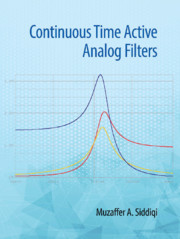Book contents
- Frontmatter
- Dedication
- Contents
- Preface
- Acknowledgments
- 1 Analog Filter: Concepts
- 2 First-and Second-order Filters
- 3 Magnitude Approximations
- 4 Delay: Approximation and Optimization
- 5 Frequency and Impedance Transformations
- 6 Sensitivity of Active Networks
- 7 Single Amplifier Second-order Filters
- 8 Multi Amplifier Second-order Filter Sections
- 9 Direct Form Synthesis: Element Substitution and Operational Simulation
- 10 Cascade Approach: Optimization and Tuning
- 11 Amplification and Filtering in Biomedical Applications
- 12 Audio Signal Processing and Anti-aliasing Filters
- 13 Follow the Leader Feedback Filters
- 14 Switched Capacitor Circuits
- 15 Operational Transconductance Amplifier-C Filters
- 16 Current Conveyors and CDTA (Current Differencing Transconductance Amplifiers) Based Filters
- 17 Active R and Active C Filters
- Index
- References
16 - Current Conveyors and CDTA (Current Differencing Transconductance Amplifiers) Based Filters
Published online by Cambridge University Press: 24 December 2019
- Frontmatter
- Dedication
- Contents
- Preface
- Acknowledgments
- 1 Analog Filter: Concepts
- 2 First-and Second-order Filters
- 3 Magnitude Approximations
- 4 Delay: Approximation and Optimization
- 5 Frequency and Impedance Transformations
- 6 Sensitivity of Active Networks
- 7 Single Amplifier Second-order Filters
- 8 Multi Amplifier Second-order Filter Sections
- 9 Direct Form Synthesis: Element Substitution and Operational Simulation
- 10 Cascade Approach: Optimization and Tuning
- 11 Amplification and Filtering in Biomedical Applications
- 12 Audio Signal Processing and Anti-aliasing Filters
- 13 Follow the Leader Feedback Filters
- 14 Switched Capacitor Circuits
- 15 Operational Transconductance Amplifier-C Filters
- 16 Current Conveyors and CDTA (Current Differencing Transconductance Amplifiers) Based Filters
- 17 Active R and Active C Filters
- Index
- References
Summary
Introduction
All conventional analog circuits are voltage mode (VM) circuits, where the performance of the circuit is determined in terms of voltage levels at all nodes including those at the input and output nodes; operational amplifiers (OAs), being the most commonly used active device, is a voltage controlled voltage source (VCVS). Unfortunately, VM circuits do suffer from some limitations: (i) voltages in the circuit cannot change very quickly when input voltage changes suddenly due to parasitic capacitances; (ii) the bandwidth of OA based circuits is usually limited to the audio frequency range unless high bandwidth OAs are used; and (iii) circuits generally do not have high voltage swings and require high supply voltages for better signal-to-noise ratio.
In the current mode (CM) approach, the circuit description is presented in terms of current. This implies that all signals, including those at the input and the output are taken in terms of current rather than voltage and the active devices used are preferably CM devices. Hence, CM signal processing techniques can be defined as the processing of current signals in an environment where voltage signals become irrelevant in determining circuit performance, although CM devices do generate VM circuits as well [16.1].
Advancements in IC (integrated circuits) technologies together with the demand for smaller and low power devices have necessitated in the development of monolithic IC filters, not only at audio frequency but at a much higher frequency range. The advent of sub-micron IC processing (0.5 μm and smaller) has facilitated the realization of filters even in the VHF frequency (30–300 MHz) band. Together with its high frequency operation, reduction in power consumption is another advantage of CM filter circuits. In view of this, attention is being paid toward signal processing in terms of current rather than voltage. This new type of signal processing is known as CM signal processing and is evolving into a better alternative to VM signal processing, especially in the high frequency region.
CM signal processing leads to a higher frequency range of operation because the signal current is delivered to a small (ideally short circuit) load resistance. Due to this small resistance, the parasitic pole frequency becomes very high. As a result, signals are processed without any appreciable deviation for much larger frequencies.
- Type
- Chapter
- Information
- Continuous Time Active Analog Filters , pp. 493 - 537Publisher: Cambridge University PressPrint publication year: 2020



